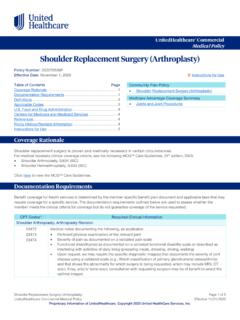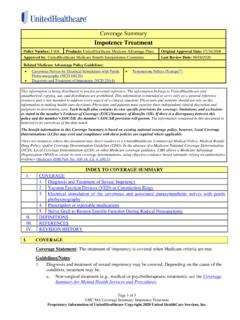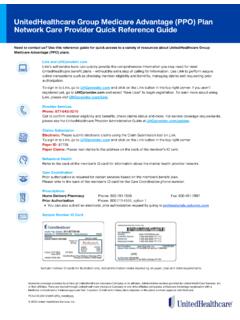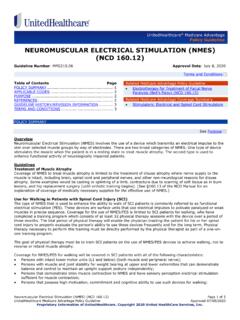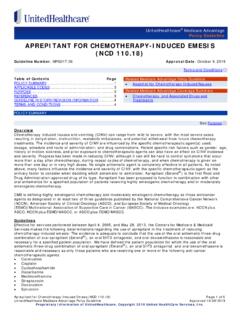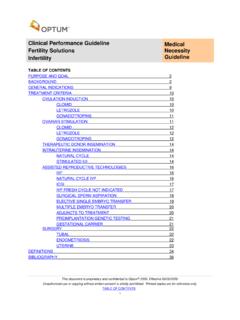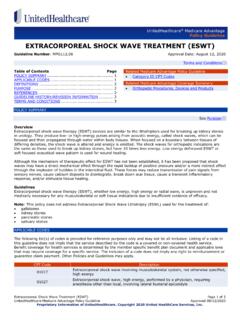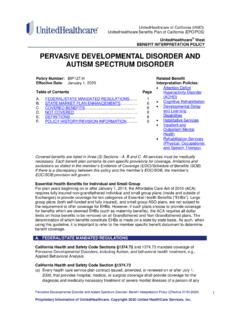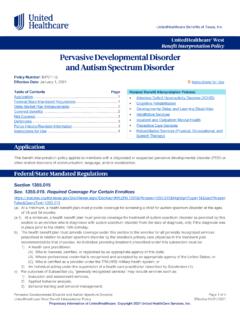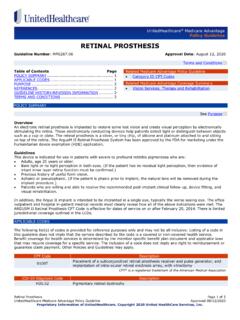Transcription of Outpatient Surgical Procedures – Site of Service
1 Outpatient Surgical Procedures Site of Service Page 1 of 5 UnitedHealthcare Commercial Utilization Review Guideline Effective 11/01/2019 Proprietary Information of UnitedHealthcare. Copyright 2019 United HealthCare Services, Inc. Outpatient Surgical Procedures SITE OF Service Guideline Number: Effective Date: November 1, 2019 Table of Contents Page COVERAGE RATIONALE .. 1 DOCUMENTATION REQUIREMENTS .. 2 DEFINITIONS .. 2 APPLICABLE CODES .. 3 REFERENCES .. 3 GUIDELINE HISTORY/REVISION INFORMATION .. 4 INSTRUCTIONS FOR USE .. 4 COVERAGE RATIONALE UnitedHealthcare members may choose to receive Surgical Procedures in an ambulatory Surgical center (ASC) or other locations. We are conducting site of Service medical necessity reviews, however, to determine whether the Outpatient hospital department is medically necessary, in accordance with the terms of the member s benefit plan.
2 If the Outpatient hospital department is not considered medically necessary, this location will not be covered under the member s plan. Certain planned Surgical Procedures performed in a hospital Outpatient department are considered medically necessary for an individual who meets ANY of the following criteria: Advanced liver disease (MELD Score > 8) Advance Surgical planning determines an individual requires overnight recovery and care following a Surgical procedure Anticipated need for transfusion Bleeding disorder requiring replacement factor or blood products or special infusion products to correct a coagulation defect Brittle Diabetes Cardiac arrhythmia (symptomatic arrhythmia despite medication) Chronic obstructive pulmonary disease (COPD) (FEV1 <50%) Coronary artery disease ([CAD]/peripheral vascular disease [PVD]) (ongoing cardiac ischemia requiring medical management recently placed [within 1 year] drug eluting stent)
3 Developmental stage or cognitive status warranting use of a hospital Outpatient department End stage renal disease ([hyperkalemia above reference range] peritoneal or hemodialysis) History of cerebrovascular accident (CVA) or transient ischemic attack (TIA) (recent event [< 3 months]) History of myocardial infarction (MI) (recent event [< 3 months]) Individuals with drug eluting stents (DES) placed within one year or bare metal stents (BMS) or plain angioplasty within 90 days unless acetylsalicylic acid and antiplatelet drugs will be continued by agreement of surgeon, cardiologist and anesthesia Less than 19 years of age Ongoing evidence of myocardial ischemia Poorly Controlled asthma (FEV1 < 80% despite medical management) Pregnancy Prolonged surgery (> 3 hours) Resistant hypertension (Poorly Controlled) Related Commercial Policies Cosmetic and Reconstructive Procedures Femoroacetabular Impingement Syndrome Hysterectomy for Benign Conditions Light and Laser Therapy Manipulation Under Anesthesia Obstructive Sleep Apnea Treatment Occipital Neuralgia and Headache Treatment Oral Surgery.
4 Non-Pathologic Excisional Procedures Percutaneous Vertebroplasty and Kyphoplasty Sodium Hyaluronate Temporomandibular Joint Disorders Community Plan Policy Outpatient Surgical Procedures Site of Service UnitedHealthcare Commercial Utilization Review Guideline Instructions for Use Outpatient Surgical Procedures Site of Service Page 2 of 5 UnitedHealthcare Commercial Utilization Review Guideline Effective 11/01/2019 Proprietary Information of UnitedHealthcare. Copyright 2019 United HealthCare Services, Inc. Severe valvular heart disease Sleep apnea (moderate to severe Obstructive Sleep Apnea (OSA) Uncompensated chronic heart failure (CHF) (NYHA class III or IV) A planned Surgical procedure performed in a hospital Outpatient department is considered medically necessary if there is an inability to access an ambulatory Surgical center for the procedure due to ANY one of the following: There is no geographically accessible ambulatory Surgical center that has the necessary equipment for the procedure; or There is no geographically accessible ambulatory Surgical center available at which the individual s physician has privileges.)
5 Or An ASC s specific guideline regarding the individual s weight or health conditions that prevents the use of an ASC Planned Surgical Procedures List Site of Service medical necessity reviews will be conducted for Surgical Procedures on the Applicable Codes List only when performed in an Outpatient hospital setting. DOCUMENTATION REQUIREMENTS Benefit coverage for health services is determined by the member specific benefit plan document and applicable laws that may require coverage for a specific Service . The documentation requirements outlined below are used to assess whether the member meets the clinical criteria for coverage but do not guarantee coverage of the Service requested. CPT Codes* Required Clinical Information Outpatient Surgical Procedures Site of Service Refer to the Applicable Codes section for a complete list of codes and their descriptions.
6 Medical notes documenting all of the following: History Physical examination including patient weight and co-morbidities Surgical plan Physician privileging information related to the need for the use of the hospital Outpatient department American Society of Anesthesiologists (ASA) score, as applicable In addition to the above, additional documentation requirements may apply for the following codes. Review the below listed policies in conjunction with the guidelines in this document. For 15576, refer to the Coverage Determination Guideline titled Cosmetic and Reconstructive Procedures For 17106, 17107 and 17108, refer to the Medical Policy titled Light and Laser Therapy For 20551, 20552, 20553, 29800 and 29804, refer to the Medical Policy titled Temporomandibular Joint Disorders For 20605, 20606, 20610, 201611, refer to the Medical Benefit Drug Policy titled Sodium Hyaluronate For 22513 and 22514, refer to the Medical Policy titled Percutaneous Vertebroplasty and Kyphoplasty For 23700 and 27570, refer to the Medical Policy titled Manipulation Under Anesthesia For 29914, 29915 and 29916.
7 Refer to the Medical Policy titled Femoroacetabular Impingement Syndrome For 42145, refer to the Medical Policy titled Obstructive Sleep Apnea Treatment For 58263, refer to the Medical Policy titled Hysterectomy for Benign Conditions For 62281, refer to the Medical Policy titled Occipital Neuralgia and Headache Treatment DEFINITIONS ASA Physical Status Classification System Risk Scoring Tool: While anesthesia providers use this scale to indicate one's overall physical health or "sickness" preoperatively, it is regarded by hospitals, law firms, accrediting boards and other healthcare groups as a scale to predict risk and thus decide if a patient should have or should have had an operation.
8 To predict operative risk, age and obesity, the nature and severity of the operative procedure, selection of anesthetic techniques, the competency of the Surgical team (surgeon, anesthesia providers and assisting Outpatient Surgical Procedures Site of Service Page 3 of 5 UnitedHealthcare Commercial Utilization Review Guideline Effective 11/01/2019 Proprietary Information of UnitedHealthcare. Copyright 2019 United HealthCare Services, Inc. staff), duration of surgery or anesthesia, availability of equipment, medicine, blood, implants and especially the level of post-operative care etc. are often far more important than multiple ASA classification. Brittle Diabetes: Diabetes that is difficult to control due to symptoms such as (1) predominant hyperglycemia with recurrent ketoacidosis, (2) predominant hypoglycemia, and (3) mixed hyper- and hypoglycemia.
9 Obstructive Sleep Apnea (OSA): Severity is defined as: Moderate for AHI or RDI 15 and 30. Severe for AHI or RDI > 30/hr. Poorly Controlled: Requiring three or more drugs to control blood pressure. APPLICABLE CODES The following list(s) of procedure and/or diagnosis codes is provided for reference purposes only and may not be all inclusive. Listing of a code in this guideline does not imply that the Service described by the code is a covered or non-covered health Service . Benefit coverage for health services is determined by the member specific benefit plan document and applicable laws that may require coverage for a specific Service . The inclusion of a code does not imply any right to reimbursement or guarantee claim payment.
10 Other Policies and Guidelines may apply. CPT/HCPCS Codes Outpatient Surgical Procedures Site of Service : CPT/HCPCS Code List REFERENCES American Heart Association. Classes of Heart Failure. Available at: Accessed August 2, 2019. American Society of Anesthesiologists (ASA) Physical Status Classification System. American Society of Anesthesiologists. Guidelines for ambulatory anesthesia and surgery. October 17, 2018. American Society of Anesthesiologists. Guidelines for patient care in anesthesiology. October 26, 2016. Bilimoria K, Liu Y, Paruch J, et al. Development and evaluation of the Universal ACS NSQIP Surgical Risk Calculator: a decision aide and informed consent tool for patients and surgeons.
